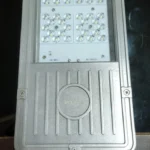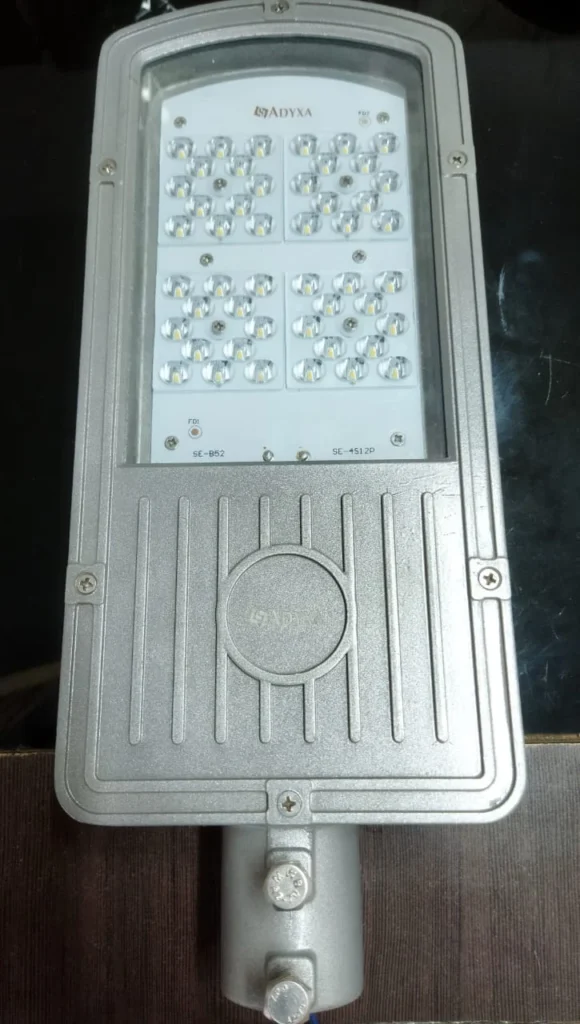

Key Features
1. Power Consumption (Wattage)
- Range: Typically between 20W to 400W.
- Description: The power rating indicates the amount of electrical energy consumed by the street light. Lower wattages (20-60W) are suitable for residential streets and pathways, while higher wattages (100-400W) are used for main roads, highways, or large public areas.
2. Luminous Flux (Lumen Output)
- Range: Usually ranges from 2,000 lumens to over 50,000 lumens.
- Description: Lumen output measures the total amount of visible light emitted by the street light. Higher lumen values provide brighter light, which is essential for areas requiring high visibility, such as highways or intersections.
3. Color Temperature (Kelvin)
- Range: Typically from 2700K (warm white) to 6500K (cool daylight).
- Description: Color temperature affects the color and tone of the light. Warm white (2700-3000K) is often used in residential areas for a softer, more inviting ambiance, while cool white or daylight (4000-6500K) is used for public streets and highways to provide clear visibility.
4. Color Rendering Index (CRI)
- Range: Typically 70-90 or higher.
- Description: CRI measures how accurately the light source displays the colors of objects compared to natural light. A CRI of 70 or higher is generally sufficient for street lighting, with higher values preferred for areas where color differentiation is important.
5. IP Rating (Ingress Protection)
- Range: Commonly IP65, IP66, or higher.
- Description: The IP rating indicates the level of protection against dust and water. An IP65 or higher rating ensures that the street light can withstand various weather conditions, including rain, dust, and moisture.
6. Voltage
- Range: Typically 100-277V AC for standard street lights; some may support 347-480V AC.
- Description: The operating voltage should match the local electrical supply. Some street lights are designed to handle a wide range of voltages, making them versatile for different regions or applications.
7. Material and Housing
- Materials: Die-cast aluminum for the housing (for durability and heat dissipation) and polycarbonate or tempered glass for the lens.
- Description: The construction material affects the durability, heat management, and resistance to corrosion and impact. Quality materials ensure the street light can withstand harsh environmental conditions.
8. Mounting Height
- Range: Typically between 4 to 12 meters (13 to 40 feet).
- Description: The mounting height varies depending on the application and area coverage. Residential streets may use lower mounting heights (4-6 meters), while highways and major roads may require taller poles (10-12 meters).
9. Beam Angle and Light Distribution
- Types: Type I, II, III, IV, V light distributions.
- Description: The beam angle and light distribution determine how light is spread over the area. For example:
- Type I: Suitable for narrow pathways or sidewalks.
- Type II: Ideal for wider walkways, paths, and roadways.
- Type III: Common for roadways and parking lots.
- Type IV: Used for wider areas or the sides of roadways.
- Type V: Provides circular or square lighting distribution, ideal for intersections or open areas.
10. Dimming and Control Options
- Types: Manual dimming, smart controls (DALI, Zigbee, Bluetooth, Wi-Fi), photocells, motion sensors, timers.
- Description: Many street lights come with dimming capabilities and smart control options that adjust brightness based on ambient light, time of day, or motion detection to save energy and reduce light pollution.
11. Lifespan
- Range: Typically 50,000 to 100,000 hours for LED street lights.
- Description: The operational life of the street light indicates how long it will function effectively before needing replacement. LED lights generally offer longer lifespans compared to traditional lighting.
12. Efficiency (Lumens per Watt)
- Range: Usually between 100 to 200 lm/W.
- Description: Efficiency measures how effectively the street light converts electrical energy into visible light. Higher lumens per watt values indicate more efficient lights, which are important for reducing energy consumption and operational costs.
13. Operating Temperature
- Range: Typically from -40°C to +50°C (-40°F to +122°F) or broader.
- Description: This specifies the range of ambient temperatures within which the street light can operate safely and effectively, suitable for different climates.
14. Surge Protection
- Range: Typically 4KV to 10KV or more.
- Description: Surge protection helps protect the street light against electrical surges caused by lightning or power fluctuations, ensuring reliability and longevity.
15. Certifications and Compliance
- Types: CE, RoHS, UL, DLC, ETL, FCC, etc.
- Description: Certifications ensure that the street light meets safety, quality, and energy efficiency standards required by different regions or applications.
16. Photocell Sensor
- Feature: Built-in or external photocell sensor for dusk-to-dawn operation.
- Description: A photocell sensor automatically turns the street light on at dusk and off at dawn, providing efficient lighting control and reducing manual intervention.
17. Size and Weight
- Range: Varies based on design and wattage; from compact models (around 5-10 lbs) to larger industrial lights (20 lbs or more).
- Description: The physical dimensions and weight affect installation requirements and suitability for different pole types or mounting systems.






